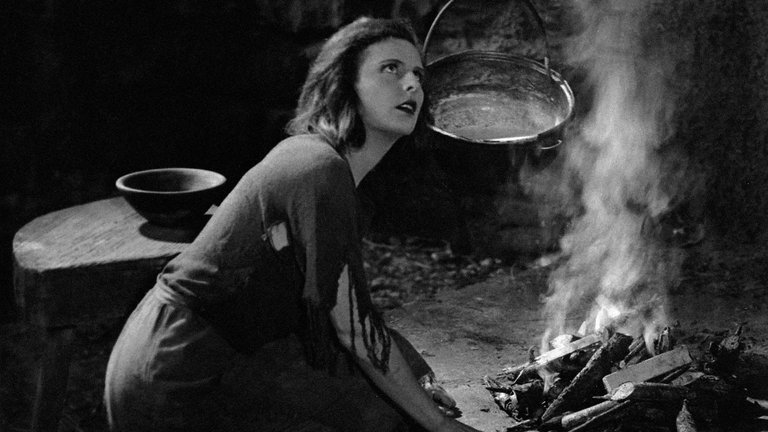Film Review: The Blue Light (Das blaue Licht, 1932)

Leni Riefenstahl is arguably the best known female director in the history of cinema, but she is also one of the most infamous. The latter is due to her association with the Nazi regime that has cast a long shadow over her remarkable talents as a filmmaker. Regardless of the controversies, that talent is quite evident in Riefenstahl's directorial debut, 1932 drama The Blue Light, is widely regarded as one of the most groundbreaking films of its time.
The plot is set in Santa Maria, a village in Dolomite mountains. The film begins in present day with a motorist and his wife arriving and being intrigued by the book featuring picture of woman who lived there many decades ago. Through flashback it is revealed that was Junta (played by Riefenstahl), a beautiful young woman living in isolation in mountains, being shunned by the villagers. This partly to the apparent curse that affects the village every full moon; then a blue light appears on the nearby mountain leading local men to climb it and lose their lives in the attempt. Villagers believe that Junta is a witch and has something to do with. When a Vigo (played by Mathias Wieman), an artist, comes to the village in order to paint the mountains, he decides to help Junta, falls in love her and ultimately solves the mystery, although his actions will inadvertently lead to tragic consequences.
The Blue Light is a quintessential example of the "mountain film" genre, a uniquely German cinematic tradition that reached its pinnacle in the interwar years. The genre, which comprises melodrama, action, and adventure, was pioneered by geologist and cinema enthusiast Arnold Fanck, with one of the best known being his 1929 film The White Hell of Pitz Palu starring Leni Riefenstahl. The production of that was an immensely demanding undertaking, but Riefenstahl's experience on the set had prepared her well for the challenges of filming of her own film on location in the Dolomites. The Blue Light would become the first "mountain film" made in sound, and one of the earliest major film productions to be shot entirely on location.
Riefenstahl's visionary direction is evident in the film's breathtaking cinematography, which captures the rugged beauty of the Dolomite landscapes. The use of light and shadow, particularly the mysterious "blue light" that draws the young men of the village to their deaths, is both visually stunning and thematically resonant. While the film's music score by Giuseppe Becce may feel somewhat old-fashioned to modern audiences, Riefenstahl's insistence on realism is evident in the quasi-documentary style of the village scenes, featuring the local inhabitants playing fictionalized versions of themselves.
Riefenstahl's performance as Junta is equally impressive, portraying a character who is not only beautiful but also resourceful and athletic. In a twist of irony, the woman who would later become the Nazis' primary film propagandist plays a character who is persecuted by her own community for being "different" and proclaimed a witch. The film even explores the language barriers between Junta and the German-speaking outsider who appears as the only one to understand her plight.
While The Blue Light is a visually stunning and well-acted film, it is not without its flaws. Like many early sound films, it still retains a somewhat silent film-like quality, with dialogue used sparingly and leaving some viewers confused by the pacing and narrative structure. The tragic ending, while adhering to the principles of old-fashioned melodrama, may feel abrupt and unsatisfying to modern audiences.
The Blue Light was a commercial success in Germany, and one of its most enthusiastic viewers was Adolf Hitler, leader of Nazi Party. This would ultimately shape Riefenstahl's career, as the Nazis would a year later come to power and ask her to become their primary film propagandist, an offer she accepted. In a controversial move, Riefenstahl even had the names of her Jewish screenwriters, Bella Balasz and Carl Mayer, erased from the credits during a later re-release of the film.
Despite the controversies that would come to define Riefenstahl's legacy, The Blue Light remains a remarkable achievement in early sound cinema. It should be recommended for fans of classic cinema and anyone interested in the work of one of the most influential and controversial filmmakers of the 20th century.
RATING: 6/10 (++)
Blog in Croatian https://draxblog.com
Blog in English https://draxreview.wordpress.com/
InLeo blog https://inleo.io/@drax.leo
Hiveonboard: https://hiveonboard.com?ref=drax
Rising Star game: https://www.risingstargame.com?referrer=drax
1Inch: https://1inch.exchange/#/r/0x83823d8CCB74F828148258BB4457642124b1328e
BTC donations: 1EWxiMiP6iiG9rger3NuUSd6HByaxQWafG
ETH donations: 0xB305F144323b99e6f8b1d66f5D7DE78B498C32A7
Posted using CineTV